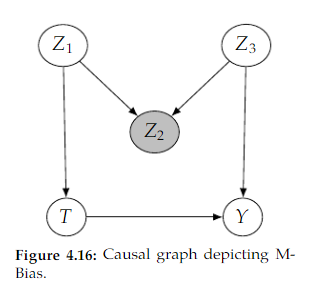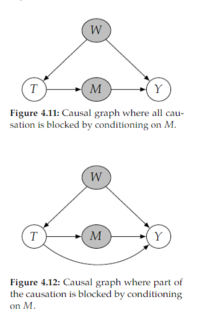Edited, memorised or added to reading queue
on 17-May-2022 (Tue)
Do you want BuboFlash to help you learning these things? Click here to log in or create user.
| status | not read | reprioritisations | ||
|---|---|---|---|---|
| last reprioritisation on | suggested re-reading day | |||
| started reading on | finished reading on |
Flashcard 7086772981004
| status | not learned | measured difficulty | 37% [default] | last interval [days] | |||
|---|---|---|---|---|---|---|---|
| repetition number in this series | 0 | memorised on | scheduled repetition | ||||
| scheduled repetition interval | last repetition or drill |
Parent (intermediate) annotation
Open itUnfortunately, even if we only condition on pretreatment co- variates, we can still induce collider bias. Consider what would happen if we condition on the collider 𝑍 2 in Figure 4.16. Doing this opens up a backdoor path, along which non-caus
Original toplevel document (pdf)
cannot see any pdfsFlashcard 7086774816012
| status | not learned | measured difficulty | 37% [default] | last interval [days] | |||
|---|---|---|---|---|---|---|---|
| repetition number in this series | 0 | memorised on | scheduled repetition | ||||
| scheduled repetition interval | last repetition or drill |
Parent (intermediate) annotation
Open itReferential integrity is a structural element that ensures that the relationships among different sets of data are accurate. In order for synthetic data — completely artificial and private production data —
Original toplevel document (pdf)
cannot see any pdfs| status | not read | reprioritisations | ||
|---|---|---|---|---|
| last reprioritisation on | suggested re-reading day | |||
| started reading on | finished reading on |
Parent (intermediate) annotation
Open itfor the backdoor adjustment (Theorem 4.2), not only did we specify that the adjustment set 𝑊 blocks all backdoor paths, but we also specified that 𝑊 does not contain any descendants of 𝑇 . Why? <span>There are two categories of things that could go wrong if we condition on descendants of 𝑇: 1. We block the flow of causation from 𝑇 to 𝑌. 2. We induce non-causal association between 𝑇 and 𝑌. <span>
Original toplevel document (pdf)
cannot see any pdfsFlashcard 7086779272460
| status | not learned | measured difficulty | 37% [default] | last interval [days] | |||
|---|---|---|---|---|---|---|---|
| repetition number in this series | 0 | memorised on | scheduled repetition | ||||
| scheduled repetition interval | last repetition or drill |
Parent (intermediate) annotation
Open itThe Positivity-Unconfoundedness Tradeoff

